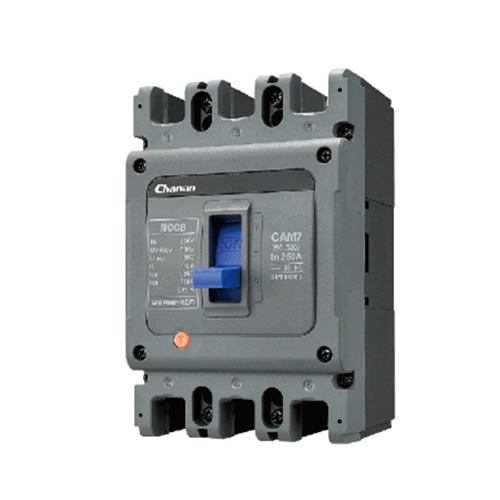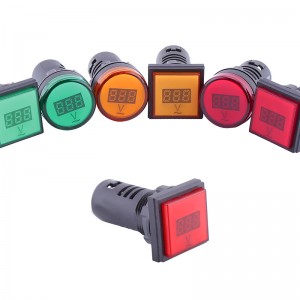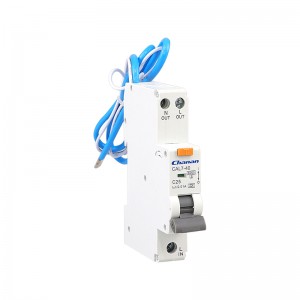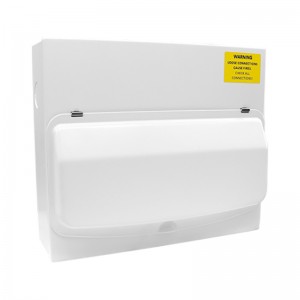CAM7 Molded Case Circuit Breaker
Scope Of Application
CAM7 Series Moulded Case Circuit Breaker (hereinafter as circuit breaker) is one of the latest circuit breakers developed by our company. The product has the characteristics of small size,high breaking, short arcing and high protection accuracy. It is an ideal product for power distribution and an updated product of the plastic external circuit breaker. It is suitable for infrequent conversion and infrequent motor starting in circuits with AC50Hz, rated operating voltage of 400V and below, and rated operating current to 800A use. The circuit breaker has overload, short circuit and under-voltage protection functions, which can protect the circuit and power equipment from damage.
This series of circuit breakers comply with IEC60947-2 and GB / T14048.2 standards.
Type Designation

Note: 1) No code for power distribution protection: circuit breaker for motor protection is indicated by 2
2) No code for three-pole products.
3) No code for handle directly operated ; the motor operation is indicated by p; the rotation of the handle operation is indicated by Z.
4) See main technical parameters.
Normal Working Condition
1. Altitude: The altitude of the installation site is 2000m and below.
2. Ambient air temperature: the ambient air temperature is not higher than + 40°C (+45°C for marine products) and not lower than -5°C, and the average temperature within 24 hours does not exceed +35°C.
3. Atmospheric conditions: when the maximum temperature is + 40°C, the relative humidity of the air does not exceed 50%, and the effective high humidity can be allowed at lower temperatures; for example, RH could be 90% at 20P. Special measures should be taken for condensation that occasionally occurs on the product due to temperature changes.
4. It can work withstand the influence of humid air, the influence of salt mist and oil mist, the carving of toxin bacteria and the influence of nuclear radiation.
5. It can work reliably under normal vibration of the ship.
6. It can work reliably under the condition of a slight earthquake (level 4).
7. It can work in the medium without explosion hazard, and the medium does not have enough gas and conductive dust to corrode the metal and destroy the insulation.
8. It can work in a place free from rain and snow.
9. It can work in the maximum inclination is ±22.5°.
10. Pollution degree is 3
11. Installation category: The installation category of the main circuit breaker is II, and the installation category of auxiliary circuits and control circuits not connected to the main circuit is II.
Classification
1. According to product pole number: classify into 2 poles, 3 poles and 4 poles. The forms of neutral poles (N poles) in 4-pole products are as follows:
◇ N pole is not installed with overcurrent trip element, and the N pole is always connected,and it will not open and close with other three poles.
◇ N pole is not installed with overcurrent trip element, and N pole is open and close with other three poles (N pole is open first and then close.)
◇ N-pole installed over-current tripping components are open and close with other three poles.
◇ N-pole installed overcurrent release components will not open and close together with other three poles.
2. Classify according to the rated short-circuit breaking capacity of the circuit breaker:
L: Standard type; M. Higher breaking type; H. High breaking type;
R: Ultra high breaking type
3. Classify according to operation mode: handle direct operation, rotary handle operation, electric operation;
4. Classify according to the wiring method: front wiring, rear wiring, plug-in wiring;
5. Classify according to the installation method: fixed (vertical installation or horizontal installation)
6. Classify by use: power distribution and motor protection;
7. Classify according to the form of overcurrent release: electromagnetic type, thermal electromagnetic type;
8. Classify according to whether there are accessories: with accessories, without accessories;
The accessories are divided into internal accessories and external accessories; internal accessories have four types: shunt release under-voltage release, auxiliary contacts and alarm contacts; external accessories have rotating handle operating mechanism, electric operating mechanism, interlock mechanism and wiring terminal block, etc. The codes of internal accessories are shown in the table below.
| Accessory name | Instantaneous release | Complex trip |
| None | 200 | 300 |
| Alarm contact | 208 | 308 |
| Shunt release | 218 | 310 |
| Energy meter prepayment function | 310S | 310S |
| Auxiliary contact | 220 | 320 |
| Under-voltage release | 230 | 330 |
| Auxiliary contact and shunt release | 240 | 340 |
| Under-voltage release
Shunt release |
250 | 350 |
| Two sets of auxiliary contacts | 260 | 360 |
| Auxiliary contact and under-voltage release | 270 | 370 |
| Alarm contact and shunt release | 218 | 318 |
| Auxiliary contact and alarm contact | 228 | 328 |
| Alarm contact and under-voltage release | 238 | 338 |
| Alarm contact
Auxiliary contact and shunt release |
248 | 348 |
| Two sets of auxiliary contact and alarm contacts | 268 | 368 |
| Alarm contact
Auxiliary contact and under-voltage release |
278 | 378 |
Main Performance Indexes
1.Main Performance Indexes

2.Circuit breaker overcurrent protection characteristics
◇ Characteristics of overcurrent inverse time protection for distribution protection
| Name of test current | I/h | Conventional time | Initial state | Ambient temperature | ||
| Ih≤63 | 63<In≤250 | In≥250 | ||||
| Conventional non – trip current | 1.05 | ≥1h | ≥2h | ≥2h | Cold state | +30℃ |
| Conventional trip current | 1.30 | <1h | <2h | <2h | Thermal state | |
| Returnable time | 3.0 | 5s | 8s | 12s | Cold state | |
◇ Characteristics of overcurrent inverse time protection for motor protection
| Name of test current | I/Ih | Conventional time | Initial state | Ambient temperature | |
| 10<In≤250 | 250≤In≤630 | ||||
| Conventional non – trip current | 1.0 | ≥2h | Cold state | +40℃ | |
| Conventional trip current | 1.2 | <2h | Thermal state | ||
| 1.5 | ≤4min | ≤8min | Cold state | ||
| Returnable time | 7.2 | 4s≤T≤10s | 6s≤T≤20s | Thermal state | |
◇ Short-circuit setting value of instantaneous release
| Inm A | For power distribution | For motor protection |
| 63、100、125、250、400 | 10In | 12In |
| 630 | 5In and 10In | |
| 800 | 10In |
3. Parameters of internal accessories of circuit breaker
◇ The rated working voltage of the undervoltage release is: AC50HZ, 230V, 400V; DC110V. 220V and so on.
Undervoltage release should act when voltage drops to within 70% and 35% of the reated voltage.
The undervoltage release should not be able to close to prevernt the circuit breaker from closing when voltage is lower than 35% of the rated voltage.
The undervoltage relase should ensure to be closed and ensure reliable closing of the circuit breaker when voltage is equal to or greater than 85% of the rated voltage.
◇ Shunt release
The rated control voltage of the shunt release is: AC50HZ 230V, 400V; DC100V, 220V, etc.
Shunt release can work reliably when the rated voltage value is at 70% and 110%.
◇ The rated current of auxiliary contact and alarm contact
| Classification | Frame rated current Inm(A) | Conventional thermal current Inm(A) | Rated working current at AC400V Ie(A) | Rated working current at DC220V Ie(A) |
| Auxiliary contact | ≤250 | 3 | 0.3 | 0.15 |
| ≥400 | 6 | 1 | 0.2 | |
| Alarm contact | 10≤Inm≤800 | AC220V/1A、DC220V/0.15A | ||
4. Electric operating mechanism
◇ The rated working voltage of the electric operating mechanism are: AC50HZ 110V、230V;DC110V、220V, etc.
◇ Motor power consumption of the electric operating mechanism is shown in the table below.
| Power distribution circuit breaker | Starting current | Power consumption | Power distribution circuit breaker | Starting current | Power consumption |
| CAM7-63 | ≤5 | 1100 | CAM6-400 | ≤5.7 | 1200 |
| CAM7-100(125) | ≤7 | 1540 | CAM6-630 | ≤5.7 | 1200 |
| CAM7-250 | ≤8.5 | 1870 |
◇ Installation height of electric operating mechanism


Outline And Installation Dimensions
◇ Front Wiring


Installation, Use And Maintenance
1. Close and open the circuit breaker several times to check whether the operating mechanism of the circuit breaker is stuck and whether the mechanism is reliable.
2. The “N”, “1″, “3″ and “5″ of the breaker are the input ends, and the “N”, “2″, “4″ and “6″ are the output ends, no flipping is allowed.
3. The cross-section area of the connecting wire selected when the circuit breaker is wired should be matched with the rated current. Refer to the table below for the cross-section of the main circuit wire when using copper wires and copper bars.
| Rated current (A) | 10 | 16
20 |
25 | 32 | 40
50 |
63 | 80 | 100 | 125
140 |
160 | 180
200 225 |
250 | 315
350 |
400 |
| Conductor crosssection area(mm2) | 1.5 | 2.5 | 4 | 6 | 10 | 16 | 25 | 35 | 50 | 70 | 95 | 120 | 185 | 240 |
| Rated current value (A) | Cable | Copper bar | ||
| Cross-section area( mm2) | Quantity | Size(mm×mm) | Quantity | |
| 500 | 150 | 2 | 30×5 | 2 |
| 630 | 185 | 2 | 40×5 | 2 |
| 800 | 240 | 3 | 50×5 | 2 |
4. Confirm that all terminal connections and fixing screws should be tightened without looseness before use.
5. Install the circuit breaker separately and fix it vertically in a dry and ventilated place. It should be easy to maintain and operate, generally 1≥1.5 meters from the ground.
6. Confirm that there are no short-circuits or short-circuits to ground between the terminals or exposed live parts.
7. After the circuit breaker is overloaded, it is necessary to find out the reason and eliminate the fault. After the bimetal in the circuit breaker is reset, the circuit can be energized.







